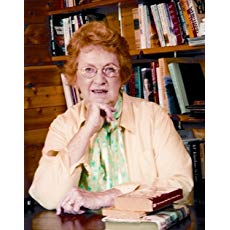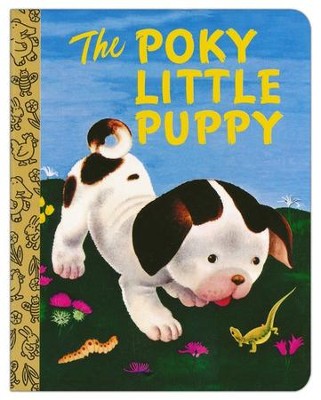Editor’s Note: You may have to be of a certain age for Little Golden Books to tweak your memory, but there was a lot of appreciate in those foil-spined picture books.
Remember The Little Golden Books?
Originally published on the Tumblon website, August 2, 2009

Probably somewhere in the house in which you grew up there is at least one copy of The Little Golden Books. Do you remember The Poky Little Puppy with the puppy reading that wonderful sign posted on the fence, “No desserts ever unless puppies never dig holes under this fence again”? Or The Saggy Baggy Elephant? Or Scuffy the Tugboat?
I have just finished reading Golden Legacy by Leonard S. Marcus, written in 2007 to honor the 65th anniversary of The Little Golden Book series. It’s an amazing story of American entrepreneurship. It’s a venture that started in the early 1900s when E.H. Wadewitz took the risk of buying out a struggling printer. With the purchase of the business came a carload of cheaply produced juvenile books that had been ordered by a company gone bankrupt. Wadewitz hired a salesman to market this unwanted inventory. In the process he discovered that there was a market for inexpensively priced books for children.
One good idea led to another. The company produced jig-saw puzzles, color books, playing cards, then added a series of Big Little Books based on comic strip characters, like Dick Tracy and Flash Gordon. These pulp fiction pieces sold for ten cents and salesman convinced merchants to position the product next to the needles and threads or the biscuit cutters and apple corers to help them sell. They convinced Walt Disney to release a book on his new character Mickey Mouse, which led to almost immediate sales of 600,000. Mass marketing meant success.
Western Publishing Company had by now attracted a team of creative people and in 1936 the company opened a new office in New York, called Artists and Writers Guild, hiring Lucille Ogle as editor. The most consequential publishing relationship Ogle initiated was with Simon & Schuster, a relatively new publishing house. Simon & Schuster were mavericks, both American-born Jews who realized that their way was barred to the clubby, old-guard publishing houses of New York. The first thing S & S published was a cross-word puzzle book—which hardly qualified as a book in the eyes of their betters—but it sparked a national craze and put them on the road to success.
By 1938 the Depression was nearly over. Time was ripe for a children’s book series that was high-quality in content and in presentation—and cost 25 cents, affordable to families who did not visit bookstores where books usually sold for $2. The secret was to sell in heavily trafficked areas where people normally shopped. Display racks were free from the publisher, designed to attract shoppers. Simon & Schuster, eager to trump the snobbery of the publishing establishment, were eager to join with Ogle and the project. The Little Golden Books would be published in sets of four.
A major asset in the success of The Little Golden Books was the availability of artists and writers who wanted desperately to be published—people like Margaret Wise Brown, Janette Sebring Lowrey, Ruth Krauss and illustrators like Garth Williams, Gustaf Tenggren, Richard Scarry and many others—who had been waiting during the depression years for an opportunity to publish. The Golden Book series did not even put their names on the covers, and often they were paid a flat fee of seventy-five dollars for the book, but they got published. Eleanor Roosevelt helped by urging parents to read to their children in her daily column, My Day.

The first printing of 600,000 of the series of four Golden Books, released in October 1942, sold out so rapidly that Simon & Schuster cancelled a wave of advertisements they had planned lest they couldn’t keep up with the demand. Even so, within five months the third printing was exhausted for a total of 1.5 million sold, and back orders of an additional 2 million. The publishers had to apologize to merchants for the shortfall, and postponed the release of four more titles until 1943.
For all its success, the librarians had little to do with The Golden Books. The professional journals like the American Library Association Booklist and Horn Book Magazine—the gatekeepers and cultural guardians of children’s books—had a strong dislike for anything cheaply produced without the authority of their expertise. They lumped the Golden Books in with their disdain for the Horatio Alger books, Tom Swift and The Hardy Boys. Good books were not sold in grocery or drug stores!
Lucille Ogle and her staff did everything they could to assure parents of the quality of The Golden Books. The books carried the assurance that they were “under the supervision of Dr. Mary Reed of Teacher’s College, Columbia University”. The books were numbered, so readers could collect a set. The size was uniform. Remember the plaque inside the front cover, “This book belongs to…” ? The original first twelve books gave a complete library to a preschooler—all for the price of one traditional book. What a bargain! By 1946 six million copies were sold in February alone!
You can still buy certain anniversary editions of The Little Golden Books, but not for 25 cents. The originals are collector items. Well over two generations of children have read these books. Sir Arthur Conan Doyle once said, “It is a great thing to start life with a small number of really good books which are your very own.” The Little Golden Books have given that gift to millions of children.
My chief joy in reading this book by Marcus was seeing again the covers of these wonderful stories: The Scrawny, Tawny Lion, Tootle, The Little Red Hen, Mother Goose, The Happy Man and His Dump Truck—and all the others.
© Gladys M. Hunt 2008-10, reissued in 2022 with minor adjustments with permission of the Executor of the Literary Estate of Gladys M. Hunt (4194 Hilton SE, Lowell, MI 49331). Used by permission. All rights reserved.
Stay Up to Date!
Get the information you need to make wise choices about books for your children and teens.
Our weekly newsletter includes our latest reviews, related links from around the web, a featured book list, book trivia, and more. We never sell your information. You may unsubscribe at any time.
Support our writers and help keep Redeemed Reader ad-free by joining the Redeemed Reader Fellowship.
Stay Up to Date!
Get the information you need to make wise choices about books for your children and teens.
Our weekly newsletter includes our latest reviews, related links from around the web, a featured book list, book trivia, and more. We never sell your information. You may unsubscribe at any time.
We'd love to hear from you!
Our comments are now limited to our members (both Silver and Golden Key). Members, you just need to log in with your normal log-in credentials!
Not a member yet? You can join the Silver Key ($2.99/month) for a free 2-week trial. Cancel at any time. Find out more about membership here.
2 Comments
Leave a Comment
You must be logged in to post a comment.

I grew up reading many of these stories and so did my children, who are only in their teens and twenties. The stories are sweet and the illustrations gentle and beautiful and full of details that children love to study and adults love to see again.
Indeed, Joy! And they formed an indelible part of our childhood!